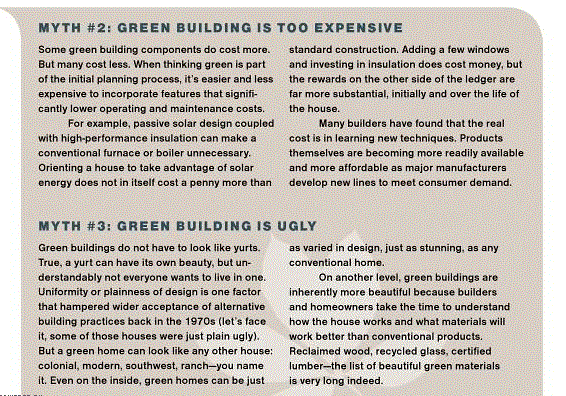The book Green from the Ground Up – Sustainable, healthy, and energy-efficient home construction byDavid Johnston and Scott Gibson is one of my suggested books for Eco Brooklyn’s rookie workers and interns.
The book is very similar to Your Green Home – A Guide to Planning a Healthy, Environmentally Friendly, New Home by Alex Wilson, another excellent primer book I also recommend.
I like Green from the Ground Up a little more than Your Green Home in terms of glossy pictures and clarity. They have lots of great images and nice graphics that stimulate the eye. But that comes with a cost I would prefer to forego since the paper they used to print is not recycled. A lot of trees were cut down to make the book.
Your Green Home is more traditional with black and white images, and thus not so glam. But it says very humbly in small print (you have to look for it) that the book is “Ancient Forest Friendly: Printed on 100% Post-Consumer Recycled Paper.” Could a green building book be printed on anything BUT recycled paper? Of course not.

Still, Green from the Ground Up, is a great book for anyone, master builder to novice. I like to flip through it and see how they describe things. It helps me when I’m explaining to say a client or a visiting class to our show house. It is also great to have the whole green building spectrum clearly organized into one book.
It is like a mini crash course in everything green building related.
As a New York green contractor part of our role is education and outreach, especially within our own team of builders. We are constantly learning and educating. And often we are discussing things with people who know nothing about green building but want to know more.
Green from the Ground Up and Your Green Home are easy to point to for something meaty. We also point them to our web site which has a lot of info. But the books are much more tangible and something they can read while commuting.
One of my criticisms of Green from the Ground Up (I have many. See this post) is that the book lacks info on the various rating systems and building techniques currently available. They only mention LEED and NAHB, both pretty tame rating systems. They also say that LEED is the only program that puts the exact requirements for earning green building status in writing and also the only program that requires third party verification.
This is incorrect. A much more effective green building rating system is the Passive House Standard, which also has very clear written guidelines and a rigorous approval process. In terms of stringent guidelines and energy efficiency of the finished home, Passive House makes LEED look like amateur fluff.
I am a LEED AP and also took the training for Passive House. Eco Brooklyn decided long ago that Passive House building is a key ingredient in green building and that LEED was a waste of money. So for the book to not list Passive House was a major oversight.
But despite that the book is a good general reference for seasoned builders and a good primer for newbies.
